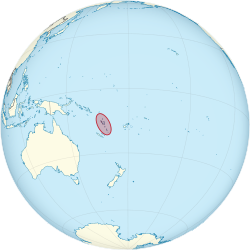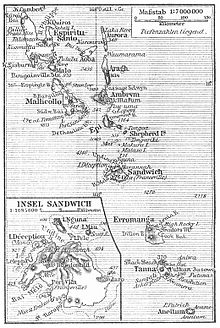New Hebrides Condominium Condominium des Nouvelles-Hébrides | |||||||||
|---|---|---|---|---|---|---|---|---|---|
| 1906–1980 | |||||||||
 | |||||||||
| Capital | Port Vila | ||||||||
| Common languages | English, French, Bislama | ||||||||
| Government | |||||||||
| Resident Commissioner | |||||||||
| Legislature | Representative Assembly (1975–1980) | ||||||||
| History | |||||||||
• Established | 20 October 1906 | ||||||||
| 30 July 1980 | |||||||||
| Currency | New Hebrides franc, Australian dollar | ||||||||
| ISO 3166 code | NH | ||||||||
| |||||||||


New Hebrides, officially the New Hebrides Condominium (French: Condominium des Nouvelles-Hébrides) and named after the Hebrides in Scotland, was the colonial name for the island group in the South Pacific Ocean that is now Vanuatu. Native people had inhabited the islands for three thousand years before the first Europeans arrived in 1606 from a Spanish expedition led by Portuguese navigator Pedro Fernandes de Queirós. The islands were named by Captain James Cook in 1774 and subsequently colonised by both the British and the French.
The two countries eventually signed an agreement making the islands an Anglo-French condominium that provided for joint sovereignty over the archipelago with two parallel administrations, one British, one French.[1] In some respects, that divide continued even after independence, with schools teaching in either one language or the other. The condominium lasted from 1906 until 1980, when New Hebrides gained its independence as the Republic of Vanuatu.
- ^ Blais, Hélène (2019). "Sharing Colonial Sovereignty? The Anglo-French Experience of the New Hebrides Condominium, 1880s–1930s". In Fichter, James R. (ed.). British and French Colonialism in Africa, Asia and the Middle East. Cambridge Imperial and Post-Colonial Studies Series. Springer International Publishing. pp. 225–247. doi:10.1007/978-3-319-97964-9_10. ISBN 9783319979649. S2CID 201397581.

